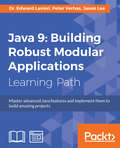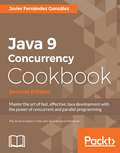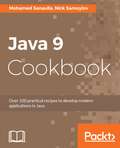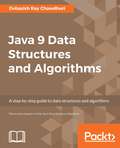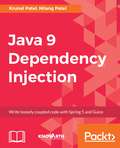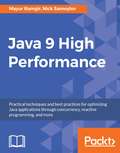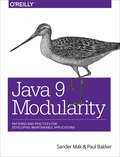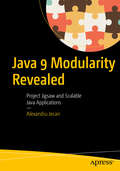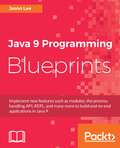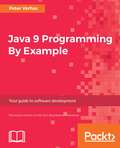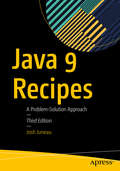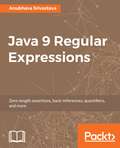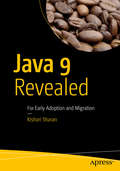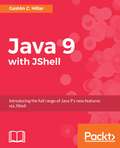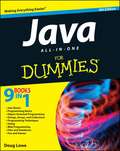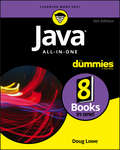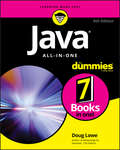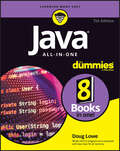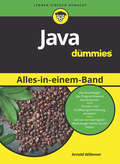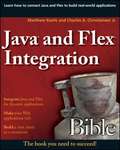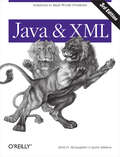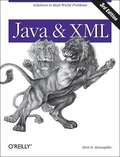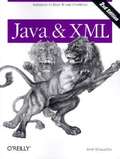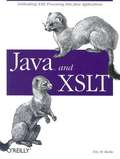- Table View
- List View
Java 9: Master advanced Java features and implement them to build amazing projects
by Dr Edward Lavieri Peter Verhas Jason LeeMastering advanced features of Java and implement them to build amazing projectsKey Features Take advantage of Java's new modularity features to write real-world applications that solve a variety of problems Explore the major concepts introduced with Java 9, including modular programming, HTTP 2.0, API changes, and more Get to grips with tools, techniques and best practices to enhance application developmentBook DescriptionJava 9 and its new features add to the richness of the language; Java is one of the languages most used by developers to build robust software applications. Java 9 comes with a special emphasis on modularity with its integration with Jigsaw. This course is your one-stop guide to mastering the language.You'll be provided with an overview and explanation of the new features introduced in Java 9 and the importance of the new APIs and enhancements. Some new features of Java 9 are ground-breaking; if you are an experienced programmer, you will be able to make your enterprise applications leaner by learning these new features. You'll be provided with practical guidance in applying your newly acquired knowledge of Java 9 and further information on future developments of the Java platform. This course will improve your productivity, making your applications faster. Next, you'll go on to implement everything you've learned by building 10 cool projects. You will learn to build an email filter that separates spam messages from all your inboxes, a social media aggregator app that will help you efficiently track various feeds, and a microservice for a client/server note application, to name just a few.By the end of this course, you will be well acquainted with Java 9 features and able to build your own applications and projects.This Learning Path contains the best content from the following two recently published Packt products:•Mastering Java 9•Java 9 Programming BlueprintsWhat you will learn Package Java applications as modules using the Java Platform Module System Implement process management in Java using the all-new process handling API Integrate your applications with third-party services in the cloud Interact with mail servers, using JavaMail to build an application that filters spam messages Use JavaFX to build rich GUI-based applications, which are an essential element of application development Leverage the possibilities provided by the newly introduced Java shell Test your application's effectiveness with the JVM harness See how Java 9 provides support for the HTTP 2.0 standardWho this book is forThis learning path is for Java developers who are looking to move a level up and learn how to build robust applications in the latest version of Java.
Java 9 Concurrency Cookbook - Second Edition
by Javier Fernandez GonzalezMaster the art of fast, effective Java development with the power of concurrent and parallel programming About This Book • Get detailed coverage of important recipes on multi-threading and parallel programming • This book takes a close look at the Java 9 APIs and their impact on concurrency • See practical examples on thread safety, high-performance classes, safe sharing, and a whole lot more Who This Book Is For The book is for Java developers and programmers at an intermediate to advanced level. It will be especially useful for developers who want to take advantage of task-based recipes using Java 9's concurrent API to program thread-safe solutions. What You Will Learn • Find out to manage the basic components of the Java Concurrency API • Use synchronization mechanisms to avoid data race conditions and other problems of concurrent applications • Separate the thread management from the rest of the application with the Executor framework • Solve problems using a parallelized version of the divide and conquer paradigm with the Fork / Join framework • Process massive data sets in an optimized way using streams and reactive streams • See which data structures we can use in concurrent applications and how to use them • Practice efficient techniques to test concurrent applications • Get to know tips and tricks to design concurrent applications In Detail Writing concurrent and parallel programming applications is an integral skill for any Java programmer. Java 9 comes with a host of fantastic features, including significant performance improvements and new APIs. This book will take you through all the new APIs, showing you how to build parallel and multi-threaded applications. The book covers all the elements of the Java Concurrency API, with essential recipes that will help you take advantage of the exciting new capabilities. You will learn how to use parallel and reactive streams to process massive data sets. Next, you will move on to create streams and use all their intermediate and terminal operations to process big collections of data in a parallel and functional way. Further, you'll discover a whole range of recipes for almost everything, such as thread management, synchronization, executors, parallel and reactive streams, and many more. At the end of the book, you will learn how to obtain information about the status of some of the most useful components of the Java Concurrency API and how to test concurrent applications using different tools. Style and approach This recipe-based book will allow you to explore the exciting capabilities of concurrency in Java. After reading this book, you will be able to comfortably build parallel applications in Java 9.
Java 9 Cookbook
by Mohamed Sanaulla Nick SamoylovA definitive guide to learning the key concepts of modern application development in Java About This Book • Learn the latest features of Java 9 • Extend your Java knowledge and take your application to new levels by making it fast, secure, and scalable • Delve into the intricacies of Modular programming in Java 9 Who This Book Is For The book is for intermediate to advanced Java programmers who want to make their applications fast, secure, and scalable. What You Will Learn • Set up JDK and know the differences in the JDK 9 installation • Implement OO designs using classes and interfaces • Manage operating system processes • Understand the new modular JDK and modular programming • Create a modular application with clear dependencies • Build graphical user interfaces using JavaFX • Use the new HTTP Client API • Learn about the new diagnostic features in Java 9 • See how to use the new jShell REPL tool • Execute ES6-compliant JavaScript code from your Java applications In Detail Java is an object-oriented programming language. It is one of the most widely accepted languages because of its design and programming features, particularly in its promise that you can write a program once and run it anywhere. This cookbook offers a range of software development examples in simple and straightforward Java 9 code, providing step-by-step resources and time-saving methods to help you solve data problems efficiently. Starting with the installation of Java, each recipe addresses a specific problem, with a discussion that explains the solution and offers insight into how it works. We cover major concepts such as Project Jigsaw and various tools that will enable you to modularize your applications. You will learn new features in the form of recipes that will make your applications modular, secure, and fast. Style and approach Each recipe in this book contains a series of complete instructions to perform a core task, plus an explanation of the purpose behind it. Similar methods or further refinements are included with each recipe to provide comprehensive guidance.
Java 9 Data Structures and Algorithms
by Debasish Ray ChawdhuriGain a deep understanding of the complexity of data structures and algorithms and discover the right way to write more efficient code About This Book • This book provides complete coverage of reactive and functional data structures • Based on the latest version of Java 9, this book illustrates the impact of new features on data structures • Gain exposure to important concepts such as Big-O Notation and Dynamic Programming Who This Book Is For This book is for Java developers who want to learn about data structures and algorithms. Basic knowledge of Java is assumed. What You Will Learn • Understand the fundamentals of algorithms, data structures, and measurement of complexity • Find out what general purpose data structures are, including arrays, linked lists, double ended linked lists, and circular lists • Get a grasp on the basics of abstract data types—stack, queue, and double ended queue • See how to use recursive functions and immutability while understanding and in terms of recursion • Handle reactive programming and its related data structures • Use binary search, sorting, and efficient sorting—quicksort and merge sort • Work with the important concept of trees and list all nodes of the tree, traversal of tree, search trees, and balanced search trees • Apply advanced general purpose data structures, priority queue-based sorting, and random access immutable linked lists • Gain a better understanding of the concept of graphs, directed and undirected graphs, undirected trees, and much more In Detail Java 9 Data Structures and Algorithms covers classical, functional, and reactive data structures, giving you the ability to understand computational complexity, solve problems, and write efficient code. This book is based on the Zero Bug Bounce milestone of Java 9. We start off with the basics of algorithms and data structures, helping you understand the fundamentals and measure complexity. From here, we introduce you to concepts such as arrays, linked lists, as well as abstract data types such as stacks and queues. Next, we'll take you through the basics of functional programming while making sure you get used to thinking recursively. We provide plenty of examples along the way to help you understand each concept. You will get the also get a clear picture of reactive programming, binary searches, sorting, search trees, undirected graphs, and a whole lot more! Style and approach This book will teach you about all the major algorithms in a step-by-step manner. Special notes on the Big-O Notation and its impact on algorithms will give you fresh insights.
Java 9 Dependency Injection: Write loosely coupled code with Spring 5 and Guice
by Nilang Patel Krunal PatelCreate clean code with Dependency Injection principlesKey FeaturesUse DI to make your code loosely coupled to manage and test your applications easily on Spring 5 and Google GuiceLearn the best practices and methodologies to implement DIWrite more maintainable Java code by decoupling your objects from their implementationsBook DescriptionDependency Injection (DI) is a design pattern that allows us to remove the hard-coded dependencies and make our application loosely coupled, extendable, and maintainable. We can implement DI to move the dependency resolution from compile-time to runtime. This book will be your one stop guide to write loosely coupled code using the latest features of Java 9 with frameworks such as Spring 5 and Google Guice. We begin by explaining what DI is and teaching you about IoC containers. Then you’ll learn about object compositions and their role in DI. You’ll find out how to build a modular application and learn how to use DI to focus your efforts on the business logic unique to your application and let the framework handle the infrastructure work to put it all together. Moving on, you’ll gain knowledge of Java 9’s new features and modular framework and how DI works in Java 9. Next, we’ll explore Spring and Guice, the popular frameworks for DI. You’ll see how to define injection keys and configure them at the framework-specific level. After that, you’ll find out about the different types of scopes available in both popular frameworks. You’ll see how to manage dependency of cross-cutting concerns while writing applications through aspect-oriented programming.Towards the end, you’ll learn to integrate any third-party library in your DI-enabled application and explore common pitfalls and recommendations to build a solid application with the help of best practices, patterns, and anti-patterns in DI. What you will learnUnderstand the benefits of DI and fo from a tightly coupled design to a cleaner design organized around dependencies See Java 9’s new features and modular frameworkSet up Guice and Spring in an application so that it can be used for DIWrite integration tests for DI applicationsUse scopes to handle complex application scenariosIntegrate any third-party library in your DI-enabled applicationImplement Aspect-Oriented Programming to handle common cross-cutting concerns such as logging, authentication, and transactions Understand IoC patterns and anti-patterns in DI Who this book is forThis book is for Java developers who would like to implement DI in their application. Prior knowledge of the Spring and Guice frameworks and Java programming is assumed.
Java 9 High Performance: Boost Your Application's Performance With The New Features Of Java 9
by Nick Samoylov Mayur RamgirBest practices to adapt and bottlenecks to avoid About This Book • Tackle all kinds of performance-related issues and streamline your development • Master the new features and new APIs of Java 9 to implement highly efficient and reliable codes • Gain an in-depth knowledge of Java application performance and obtain best results from performance testing Who This Book Is For This book is for Java developers who would like to build reliable and high-performance applications. Prior Java programming knowledge is assumed. What You Will Learn • Work with JIT compilers • Understand the usage of profiling tools • Generate JSON with code examples • Leverage the command-line tools to speed up application development • Build microservices in Java 9 • Explore the use of APIs to improve application code • Speed up your application with reactive programming and concurrency In Detail Finally, a book that focuses on the practicalities rather than theory of Java application performance tuning. This book will be your one-stop guide to optimize the performance of your Java applications. We will begin by understanding the new features and APIs of Java 9. You will then be taught the practicalities of Java application performance tuning, how to make the best use of garbage collector, and find out how to optimize code with microbenchmarking. Moving ahead, you will be introduced to multithreading and learning about concurrent programming with Java 9 to build highly concurrent and efficient applications. You will learn how to fine tune your Java code for best results. You will discover techniques on how to benchmark performance and reduce various bottlenecks in your applications. We'll also cover best practices of Java programming that will help you improve the quality of your codebase. By the end of the book, you will be armed with the knowledge to build and deploy efficient, scalable, and concurrent applications in Java. Style and approach This step-by-step guide provides real-world examples to give you a hands-on experience.
Java 9 Modularity: Patterns and Practices for Developing Maintainable Applications
by Sander Mak Paul BakkerThe upcoming Java 9 module system will affect existing applications and offer new ways of creating modular and maintainable applications. With this hands-on book, Java developers will learn not only about the joys of modularity, but also about the patterns needed to create truly modular and reliable applications. Authors Sander Mak and Paul Bakker teach you the concepts behind the Java 9 module system, along with the new tools it offers. You’ll also gain learn how to modularize existing code and how to build new Java applications in a modular way.Understand Java 9 module system conceptsMaster the patterns and practices for building truly modular applicationsMigrate existing applications and libraries to Java 9 modulesUse JDK 9 tools for modular development and migration
Java 9 Modularity Revealed
by Alexandru JecanDevelop modular applications using the Java Platform Module System, the single most anticipated feature in Java 9. You will improve maintainability and performance of your Java applications by deploying only modules that are needed and encapsulating their implementation details. Until now Java has been monolithic. Using any one part of Java has meant incorporating the entirety of the runtime environment, an approach ill-suited to the increasing number of IoT devices such as fitness monitors, kitchen appliances, toys and games, and so forth. This book shows a new way, to make Java scale from the smallest of footprints in the smallest of devices through desktop PCs and on up to server platforms. With Java 9 Modularity Revealed you will learn to make your projects more reliable and scalable than ever using the most important feature in Java 9—The Java Platform Module System, known more commonly as Project Jigsaw. You will learn how to avoid one of the major pain points of Java programming, that of conflicting class names from different modules, or packages. You will learn to create custom run-time images that represent a minimal and more compact JRE containing only those modules that you need. You will further learn to migrate existing Java applications to modular ones using different approaches and tools. The end result is a new ability to plug together different modules without fear of namespace and other conflicts, and you can deploy to everything from small devices to large servers. This book provides code examples and explanations.What You'll Learn Build Java applications using the new modular system introduced in Java 9 Create your own JRE consisting only of the modules that you require Adapt your testing techniques toward modular applicationslare your dependencies on other modules Enable modules to export only specific packages Migrate existing Java applications to modular ones Improve maintainability and performance of Java applicationsWho This Book Is ForExperienced Java programmers wanting to keep up and become informed on the new modularity support in Java 9
Java 9 Programming Blueprints
by Jason LeeBuild a variety of real-world applications by taking advantage of the newest features of Java 9 About This Book • See some of the new features of Java 9 and be introduced to parts of the Java SDK • This book provides a set of diverse, interesting projects that range in complexity from fairly simple to advanced and cover HTTP 2.0 • Take advantage of Java's new modularity features to write real-world applications that solve a variety of problems Who This Book Is For This book is for Java developers who are already familiar with the language. Familiarity with more advanced topics, such as network programming and threads, would be helpful, but is not assumed. What You Will Learn • Learn how to package Java applications as modules by using the Java Platform Module System • Implement process management in Java by using the all-new process handling API • Integrate your applications with third-party services in the cloud • Interact with mail servers using JavaMail to build an application that filters spam messages • Learn to use JavaFX to build rich GUI based applications, which are an essential element of application development • Write microservices in Java using platform libraries and third-party frameworks • Integrate a Java application with MongoDB to build a cloud-based note taking application In Detail Java is a powerful language that has applications in a wide variety of fields. From playing games on your computer to performing banking transactions, Java is at the heart of everything. The book starts by unveiling the new features of Java 9 and quickly walks you through the building blocks that form the basis of writing applications. There are 10 comprehensive projects in the book that will showcase the various features of Java 9. You will learn to build an email filter that separates spam messages from all your inboxes, a social media aggregator app that will help you efficiently track various feeds, and a microservice for a client/server note application, to name a few. The book covers various libraries and frameworks in these projects, and also introduces a few more frameworks that complement and extend the Java SDK. Through the course of building applications, this book will not only help you get to grips with the various features of Java 9, but will also teach you how to design and prototype professional-grade applications with performance and security considerations. Style and approach This is a learn-as-you-build practical guide to building full-fledged applications using Java 9. With a project-based approach, we'll improve your Java skills. You will experience a variety of solutions to problems with Java.
Java 9 Programming By Example
by Peter VerhasThis book is for anyone who wants to learn the Java programming language. You are expected to have some prior programming experience with another language, such as JavaScript or Python, but no knowledge of earlier versions of Java is assumed.
Java 9 Recipes
by Josh JuneauQuickly find solutions to dozens of common programming problems encountered while building Java applications. Content is presented in the popular problem-solution format. Look up the programming problem that you want to resolve. Read the solution. Apply the solution directly in your own code. Problem solved! This revised edition covers important new features such as Java 9's JShell and the new modularity features enabling you to separate code into independent modules that perform discrete tasks. Also covered are the new garbage collection algorithm and completely revamped process API. Enhanced JSON coverage is provided as well as a new chapter on JavaServer Faces development for web applications. What You'll Learn Develop Java SE applications using the latest in Java SE technology Exploit advanced features like modularity and lambdas Use JShell to quickly develop solutions Build dynamic web applications with JavaScript and Project Nashorn Create great-looking web interfaces with JavaServer Faces Generate graphics and work with media such as sound and video Add internationalization support to your Java applications Who This Book Is For Both beginning Java programmers and advanced Java developers
Java 9 Regular Expressions
by Anubhava SrivastavaSolve real world problems using Regex in Java. About This Book • Discover regular expressions and how they work • Implement regular expressions with Java to your code base • Learn to use regular expressions in emails, URLs, paths, and IP addresses Who This Book Is For This book is for Java developers who would like to understand and use regular expressions. A basic knowledge of Java is assumed. What You Will Learn • Understand the semantics, rules, and core concepts of writing Java code involving regular expressions • Learn about the java.util.Regex package using the Pattern class, Matcher class, code snippets, and more • Match and capture text in regex and use back-references to the captured groups • Explore Regex using Java String methods and regex capabilities in the Java Scanner API • Use zero-width assertions and lookarounds in regex • Test and optimize a poorly performing regex and various other performance tips In Detail Regular expressions are a powerful tool in the programmer's toolbox and allow pattern matching. They are also used for manipulating text and data. This book will provide you with the know-how (and practical examples) to solve real-world problems using regex in Java. You will begin by discovering what regular expressions are and how they work with Java. This easy-to-follow guide is a great place from which to familiarize yourself with the core concepts of regular expressions and to master its implementation with the features of Java 9. You will learn how to match, extract, and transform text by matching specific words, characters, and patterns. You will learn when and where to apply the methods for finding patterns in digits, letters, Unicode characters, and string literals. Going forward, you will learn to use zero-length assertions and lookarounds, parsing the source code, and processing the log files. Finally, you will master tips, tricks, and best practices in regex with Java. Style and approach This book will take readers through this learning journey using simple, easy-to-understand, step-by-step instructions and hands-on examples at every stage.
Java 9 Revealed: For Early Adoption and Migration
by Kishori SharanPreview the new Java 9 modules, SDK, JDK, JVM and more in this comprehensive early adopter title. This book covers what's new in Java 9 and how to use these new features. Java 9 Revealed is for experienced Java programmers looking to make the migration from Java 7 or Java 8 to Java 9. Author Kishori Sharan begins by covering how to develop Java applications using new the module system introduced in Java 9 and how to use the JShell tool in Java 9 for quick prototyping. There is extensive coverage of new Java 9 features, such as the new layout of the modular JDK/JRE runtime image, new convenience factory methods for creating collections, the new spin-wait hints introduced to improve performance of spin loops in your code, and the new Desktop API for implementing platform-specific desktop features. Along the way you will also learn how to use the Reactive Streams API in Java 9 and, most importantly, this book will show you the breaking changes in Java 9. What You'll Learn Discover what is new in the Process API Inspect a thread's stack with the Stack-Walking API Use the jlink tool to create a custom runtime image Work with HTML5 Javadoc and use the new search feature in Javadoc Learn how to use new methods and collectors in the Streams API Learn how to create a custom logger to log messages from platform classes and how to use JVM logs Learn about new methods in the Optional class and how to use them Learn how to compare arrays and slices of arrays Learn how to use the enhanced try-with-resources blocks Make your object deserialization more secure by using object deserialization filters Who This Book Is For Experienced Java programmers and developers.
Java 9 with JShell
by Gaston C. HillarExplore Java 9 with JShell and UML About This Book • A full account of Java 9's new features • This tutorial emphasises fluency using JShell exercises • Get a thorough introduction to contract programming code reuse via Java generics • Learn how to use the new module system • How to use proper functional programming style inside Java 9 Who This Book Is For This book can be understood by anyone who is a graduate of computer science or someone who has just begun working as a software engineer. Basically, an understanding of an object-oriented programming language like Python, C++ or indeed, an earlier Java version is sufficient. It would be helpful to have participated in the full product cycle of a software engineering project. What You Will Learn • Engage with object-oriented programming in Java 9, starting with code snippets in JShell • Optimize your code, applying functional programming features • Discover the advantages of modularity • Become very proficient at using JShell itself • Learn the new approach to Java programming, which uses the REPL as a prototyping tool In Detail The release of Java 9 has brought many subtle and not-so-subtle changes to the way in which Java programmers approach their code. The most important ones are definitely the availability of a REPL, known as JShell, which will make experiments and prototyping much more straightforward than the old IDE-based project-led approach. Another, more subtle change can be seen in the module system, which will lead to more modularized, maintainable code. The techniques to take full advantage of object-oriented code, functional programming and the new modularity features in Java 9 form the main subjects of this book. Each chapter will add to the full picture of Java 9 programming starting out with classes and instances and ending with generics and modularity in Java. Style and approach You will learn by doing: : using JShell as their prototyping environment, you will take full advantage of the new features of Java 9, in particular the full module system and the functional features of Java 9.. There won't be any theory, only small and medium-sized exampled enabling the reader to use the new Java features in professional software engineering projects.
Java All-in-One For Dummies
by LoweEverything you need to get going with Java!Java All-in-One For Dummies, 4th Edition has what you need to get up and running quickly with Java. Covering the enhanced mobile development and syntax features as well as programming improvements, this guide makes it easy to find what you want and put it to use. Focuses on the vital information that enables you to get up and running quickly with Java Covers the enhanced multimedia features as well as programming enhancements, Java and XML, Swing, server-side Java, Eclipse, and more Minibooks cover Java basics; programming basics; strings, arrays, and collections; programming techniques; Swing; Web programming; files and databases; and a "fun and games" categoryJava All-in-One For Dummies, 4th Edition focuses on the practical information you need to become productive with Java right away.
Java All-in-One For Dummies
by Doug LoweYour one-stop guide to programming with Java If you've always wanted to program with Java but didn't know where to start, this will be the java-stained reference you'll turn to again and again. Fully updated for the JDK 9, this deep reference on the world's most popular programming language is the perfect starting point for building things with Java—and an invaluable ongoing reference as you continue to deepen your knowledge. Clocking in at over 900 pages, Java All-in-One For Dummies takes the intimidation out of learning Java and offers clear, step-by-step guidance on how to download and install Java tools; work with variables, numbers, expressions, statements, loops, methods, and exceptions; create applets, servlets, and JavaServer pages; handle and organize data; and so much more. Focuses on the vital information that enables you to get up and running quickly with Java Provides details on the new features of JDK 9 Shows you how to create simple Swing programs Includes design tips on layout, buttons, and labels Everything you need to know to program with Java is included in this practical, easy-to-use guide!
Java All-in-One For Dummies
by Doug LoweJava—from first steps to first apps Knowing Java is a must-have programming skill for any programmer. It’s used in a wide array of programming projects—from enterprise apps and mobile apps to big data, scientific, and financial uses. The language regularly ranks #1 in surveys of the most popular language based on number of developers, lines of code written, and real-world usage. It’s also the language of choice in AP Computer Science classes taught in the U.S. This guide provides an easy-to-follow path from understanding the basics of writing Java code to applying those skills to real projects. Split into eight minibooks covering core aspects of Java, the book introduces the basics of the Java language and object-oriented programming before setting you on the path to building web apps and databases. • Get up to speed on Java basics • Explore object-oriented programming • Learn about strings, arrays, and collections • Find out about files and databases Step-by-step instructions are provided to ensure that you don't get lost at any point along the way.
Java All-in-One For Dummies
by Doug LoweA beginning coder’s resource for learning the most popular coding language With Java All-in-One For Dummies, you get 8 books in one, for the most well-rounded Java knowledge on the market. Updated for Java 19, this book includes all the major changes to the programming language, so you won’t fall behind. Start by learning the basics of Java—you can do it, even if you’ve never written a line of code in your life. Then go in-depth, with all the info you need on object-oriented programming, Java FX, Java web development, and beyond. Grab a hot cup of java and settle in to learn some Java, with friendly For Dummies guidance! Learn the basics of computer programming and get started with the Java language Master strings, arrays, and collections Discover the most recent Java updates and the latest in programming techniques Launch or further your career as a coder with easy-to-follow instructionThis is the go-to Dummies guide for future and current coders who need an all-inclusive guide Java to take their knowledge to the next level.
Java Alles-in-einem-Band für Dummies (Für Dummies)
by Arnold V. WillemerDieses Buch ist für alle, die tief in die Java-Programmierung einsteigen möchten. Dennoch werden keine Programmierkenntnisse vorausgesetzt. Lernen Sie zunächst, wie Sie das Java Development Kit installieren und welche Java-Elemente es gibt. Machen Sie sich dann mit Methoden und objektorientierter Programmierung vertraut. Werfen Sie Exceptions, sammeln Sie Datenelemente in flexiblen Arrays und programmieren Sie Fenster, Mäuse und Grafik. Merken Sie was? Unversehens sind Sie zum Profi geworden. Datenspeicherung, Datenbankzugriff und der Umgang mit XML-Dateien sind genauso wie die Parallelverarbeitung mit Threads und die Netzwerkprogrammierung keine Hürde mehr. Programmieren lernt man in erster Linie dadurch, dass man es tut: Deshalb sind Aufgaben vorhanden. Die Lösungen dazu und alle Codebeispiele des Buchs stehen zum Download zur Verfügung.
Java and Flex Integration Bible
by Charles A. Christiansen Matthew KeefeProviding you with invaluable information for delivering rich, cross-platform Internet applications within the enterprise and across the web, this book shows you how to fully integrate Java and Flex. Pages of examples, step-by-step instructions, and from-the-field techniques guide you through the creation of your first Java/Flex applications.
Java and XML
by Justin Edelson Brett MclaughlinJava and XML, 3rd Edition, shows you how to cut through all the hype about XML and put it to work. It teaches you how to use the APIs, tools, and tricks of XML to build real-world applications. The result is a new approach to managing information that touches everything from configuration files to web sites. After two chapters on XML basics, including XPath, XSL, DTDs, and XML Schema, the rest of the book focuses on using XML from your Java applications. This third edition of Java and XML covers all major Java XML processing libraries, including full coverage of the SAX, DOM, StAX, JDOM, and dom4j APIs as well as the latest version of the Java API for XML Processing (JAXP) and Java Architecture for XML Binding (JAXB). The chapters on web technology have been entirely rewritten to focus on the today's most relevant topics: syndicating content with RSS and creating Web 2.0 applications. You'll learn how to create, read, and modify RSS feeds for syndicated content and use XML to power the next generation of websites with Ajax and Adobe Flash. Topics include: The basics of XML, including DTDs, namespaces, XML Schema, XPath, and Transformations The SAX API, including all handlers, filters, and writers The DOM API, including DOM Level 2, Level 3, and the DOM HTML module The JDOM API, including the core and a look at XPath support The StAX API, including StAX factories, producing documents and XMLPull Data Binding with JAXB, using the new JAXB 2.0 annotations Web syndication and podcasting with RSS XML on the Presentation Layer, paying attention to Ajax and Flash applications If you are developing with Java and need to use XML, or think that you will be in the future; if you're involved in the new peer-to-peer movement, messaging, or web services; or if you're developing software for electronic commerce, Java and XML will be an indispensable companion.
Java and XML
by Brett MclaughlinThorough knowledge of both Java and XML is indispensable if developers want to build modern web applications. Because both languages are platform independent, they are ubiquitous in the world of web development, and the combination of the two allows enterprises to lower the costs of information sharing for e-commerce and other high-octane web applications and services. Our third edition of Java and XML is ideal for any Java developer who wants to take advantage of XML without having to become an expert on the markup language. So, unlike other XML titles, this book is written from a Java developer's point of view, and assumes no prior knowledge of XML. The new edition has been thoroughly revised with coverage of Java 5.0 as well as new standards for SOAP, a key web services technology that works with XML and provides a central part of Microsoft's .NET platform.
Java and XML
by Brett D. Mclaughlin Justin EdelsonThis guide first covers XML basics, including XPath, XSL, DTDs, and XML Schema, then focuses on using XML from Java applications. This third edition covers all major Java XML processing libraries, as well as the latest version of the Java API for XML Processing (JAXP) and Java Architecture for XML Binding (JAXB). The chapters on Web technology have been entirely rewritten to focus on today's most relevant topics: syndicating content with RSS and creating Web 2. 0 applications. The book will be useful to Java developers, those involved in the peer-to-peer movement, messaging, or web services, and people developing software for electronic commerce. McLaughlin is a Java and XML programmer. Edelson is a software developer. Annotation ©2008 Book News, Inc. , Portland, OR (booknews. com)
Java and XML, 2nd Edition
by Brett MclaughlinWhile the XML "buzz" still dominates talk among Internet developers, the critical need is for information that cuts through the hype and lets Java programmers put XML to work. Java and XML shows how to use the APIs, tools, and tricks of XML to build real-world applications, with the end result that both the data and the code are portable. This second edition of Java & XML adds chapters on Advanced SAX and Advanced DOM, new chapters on SOAP and data binding, and new examples throughout. A concise chapter on XML basics introduces concepts, and the rest of the book focuses on using XML from your Java applications. Java developers who need to work with XML, or think that they will in the future--as well as developers involved in the new peer-to-peer movement, messaging, or web services--will find the new Java and XML a constant companion. This book covers: The basics of XML, including DTDs, namespaces, XML Schema, XPath, and XSL The SAX API, including all handlers, the SAX 2 extensions, filters, and writers The DOM API, including DOM Level 2, Level 3, and the Traversal, Range, CSS, Events, and HTML modules. The JDOM API, including the core, a look at XPath support, and JDOM as a JSR Using web publishing frameworks like Apache Cocoon Developing applications with XML-RPC Using SOAP and UDDI for web services Data Binding, using both DTDs and XML Schema for constraints Building business-to-business applications with XML Building information channels with RSS and dynamic content with XSP Includes a quick reference on SAX 2.0, DOM Level 2, and JDOM.
Java and XSLT
by Eric M. BurkeThe power of XSLT is its ability to change the structure or format of any content that can be converted to XML. Java and XSLT shows you how to use XSL transformations in Java programs ranging from stand-alone applications to servlets. After an introduction to XSLT, the book focuses on applying transformations in some real-world scenarios, such as developing a discussion forum, transforming documents from one form to another, and generating content for wireless devices. Java and XSLT discusses several common XSLT processors and the TRAX API, paying special attention to performance issues. Although there's a brief tutorial introduction to the XSLT language, the primary focus of the book isn't on learning XSLT or developing stylesheets; it's on making practical use of transformations in Java code. The book covers: Introduction and Technology Review XSLT--The Basics XSLT--Beyond The Basics Java Web Architecture Programmatic Interfaces to XSLT Processors Using XSLT with Servlets Discussion Forum Implementation Advanced XSLT Web Techniques Testing, Tuning and Development Environments WAP and WML XSLT and Wireless Examples
